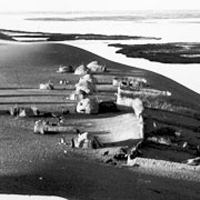
Eugenio Turri. Villages
photography exhibition
| - |
|---|
The exhibition displayed photographs taken by Eugenio Turri starting from the early 1960s.
The photographs show villages, depicted in aspects of life, form and measure, bearing witness to the scientific focus on the topic of villages. Each photograph is considered as a fragment of a complex investigation involving several trips and visits to the same place to check and confirm the assumptions on the object of the study.
It is an anthological repertoire that includes black and white as well as colour photographs, both aerial and on land, of much loved and studied places in Mali, Mauritania, Erythraea, Ethiopia, Morocco, Yemen, Afghanistan, Nepal, China and more. Eugenio Turri wrote prolifically and at different times on the relationship between geography and photography, and between photography and landscape. As early as 1969 in an article written for “L’Universo” he declared his preference for aerial photography, not overhead but oblique aerial view, as a “form of spectacle, enjoyment, geographic contemplation” afforded by aerial observation. The aerial view, which objectifies geographic reality through an externalising effect, allows the geographer to read and understand man’s signs marked on the earth’s surface. Turri’s accounts of his flights is a set of visual impressions and notes connected to the colours, textures, patterns and graphic motifs with their inescapable aesthetic component.
Below is an excerpt from Eugenio Turri, Photography and geographical illustration, “L’Universo”, 1972, no. 1, p. 83.
“… theoretically those who are able to read a landscape should be the authors of the best, most meaningful photographs. In reality this is not the case. The photographer is first and foremost someone with a photographic eye, who, in any case, knows and foresees the capabilities and limits when they are about to take the photo. This fact, the technical-photographic stumbling block, has always been one of the reasons why many geographers have never felt like photographers […]. While it is precisely the geographers, indeed, who should be photographers, because they, more than anyone else, possess the codes to read the landscape […] (It should also be noted that certain great geographers were passionate and excellent photographers, and most likely because authentic love is global possession, also expressed through a visual, photographic capture, final yet partial ). […]
Thus, the finest landscape photographs are almost invariably the work of non-geographers, although sensitive to the landscape, its moments, its shapes, the relationships it reveals, the light received and diffused by those shapes and relationships. In fact, landscape photography is beautiful not when it simply encloses peculiar light effects or aesthetic composure, but when it is true, when it captures and expresses truths that are also usually sought by the geographer…”
